We were invited to visit a 7800-acre farm about 2 days ride
NW from Newcastle. Jon's directions were: Get to Moree (700km NW of Newcastle), turn north
to Garah (50km), another 42kms to Boomi (population 80), then turn left and follow the
dirt roughly 30kms to a sign for the "Thorndale" property. It was still raining
when we slid into the farm on Tuesday evening. The big old house was empty, and we walked
into the kitchen (as instructed), found the 2-way (CB) radio, and contacted Jon. He
arrived shortly thereafter.
Following a HOT shower, dinner of fresh pork chops and even fresher vegetables were
devoured. We retired early, and woke the same – nothing too unrespectable. I wish I
could describe the house clearly: Built in the late 1800’s by Jon’s grandfather,
the kitchen and breakfast rooms are large, but built as a "wing" off the rest of
the house. This was done so if a fire broke out in the kitchen, the whole house
wouldn’t be destroyed. Completely surrounded by a covered deck, with a hallway
through the center, all the rooms have access to both the hallway and the deck. It’s
very cool and airy, which is helpful in the hot summer months.
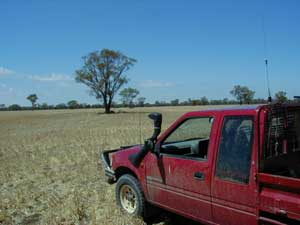 After
brecky (Aussie term for breakfast) Wednesday morning, we climbed into the Ute for our tour
of the farm. A Ute is another Aussie term for a multi-purpose small truck, similar to what
we refer to as a pick-up truck back home. In addition to the tailgate opening, the
sidewalls of the Ute can also be dropped for more efficient use – I’m surprised
this hasn’t made it to the states. OK, off we go on our tour. The 7800-acre farm
stretches roughly 5kms north to south, and a bit more east to west. There is only about
3500 acres currently being harvested, the remainder of the ground is either recovering
from a previous harvest, or still undeveloped.
After
brecky (Aussie term for breakfast) Wednesday morning, we climbed into the Ute for our tour
of the farm. A Ute is another Aussie term for a multi-purpose small truck, similar to what
we refer to as a pick-up truck back home. In addition to the tailgate opening, the
sidewalls of the Ute can also be dropped for more efficient use – I’m surprised
this hasn’t made it to the states. OK, off we go on our tour. The 7800-acre farm
stretches roughly 5kms north to south, and a bit more east to west. There is only about
3500 acres currently being harvested, the remainder of the ground is either recovering
from a previous harvest, or still undeveloped.
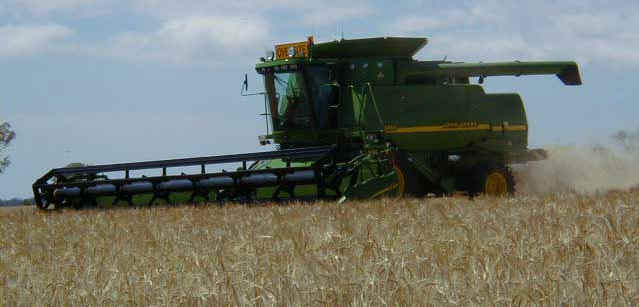 |
There’s a large Header parked in the corner of one of the fields, waiting for the
Barley to dry before it can be harvested. A Header is a large crop-harvesting machine,
with the long wide blades stretched out in front. Erin and I each catch a ride, back and
forth through the rows. As the machine rides up and down the rows, the blades cut the crop
stems that are fed into the machine's stomach. The grain is then processed (separated from
the stem), with the "garbage" ground up and dispersed out the back, and the
grain stored in a huge container. When the container is full, the Header drives to a
holding tank, and deposits the grain there. Eventually, a semi-truck will come to the
holding tank, off-load the grain, and drive it to its destination. The Header and its
driver go off to the next farm, slowly working back to the south. The Header driver, Dean,
works 18 hours a day – up and down through the rows. I asked Dean if he had a good
living – He replied "the money is real good, but it’s no life".

Erin watches as the
grain is moved from the holding container into the truck. |
In the evening, Jon’s wife Libby returned from a home furnishing show in Brisbane.
Libby started Aussie Wool Quilts several years ago, producing wool quilts and swags right
on their farm www.AussieWool.com.au A swag is a oil-skin
bed roll, very common for the bush and outback. According to Jon, the "Bush" is
where houses are several miles apart; the outback is where your closest neighbor is more
than 30 minutes away.
After her long drive back to the farm, Libby was happy to hear we had come up with a
plan for dinner: We were going to town (30kms away) for "Half-price" dinner, and
a few drinks. We arrived at the Boomi Pub around 7:30, and there was no questioning that
we were in a "local" cowboy bar. The locals were friendly, and immediately
bought me the local special – Bundaberg Rum and Coke. Jon, Libby, and Erin were a
little concerned, but after about the 10th round, I ashuuuuured them I was fine. The city
of Bundaberg (where the rum is produced) is on the East Coast, about 400kms north of
Brisbane, and we’ll be sure to stop by for a tour and a souvenir.
Thursday morning, we woke early and a little worn. I went with Jon to another nearby
town (50kms away) to deliver some goods, and get a tour of a friend's cotton farm. Cotton
is where the big money is at, and the dry climate of the area is suitable for its growth.
The key is moving water appropriately: just enough at just the right time. Irrigation is
very expensive, especially in a dry climate, and more so during a drought. Cotton farmers
maintain multiple large dams (man-made lakes big enough to water-ski on), with multiple
canals connecting the dams to the cotton fields. Cotton farming requires a lot of capital;
but then again, the profits can be quite handsome too.
We returned home around lunchtime, to find the girls had arranged an
"overnight" at Lightning Ridge about 200kms to the west. Lightning Ridge is a
mining area that "struck gold" around 1990, making many lucky miners very rich.
The opal business is a cash business, many people don’t use their birth names, and
many people don’t want to be found. Official population is about 3,500, but the local
post office utilizes over 7,000 PO Boxes.
Libby’s friends Lisa and Peter are opal dealers and they invited us to stay at
their camp, about 14kms from town, surrounded by some of their claims. A camp is
considered a living area that can be moved, although most never do. The structure is made
of a tall metal roof, supported by metal beams, with an elevated wooden floor. Under the
roof, metal corrugated walls are erected, with a straw roof above. There is a gap of
several feet between the straw and steel roofs, and windows are made of mesh, allowing for
excellent ventilation in this desert climate. Solar panels, a host of batteries, and a
couple of diesel generators power the mining tools and camp (lights, entertainment system,
fridge,…).
A
"luxury" Camp... |
 |
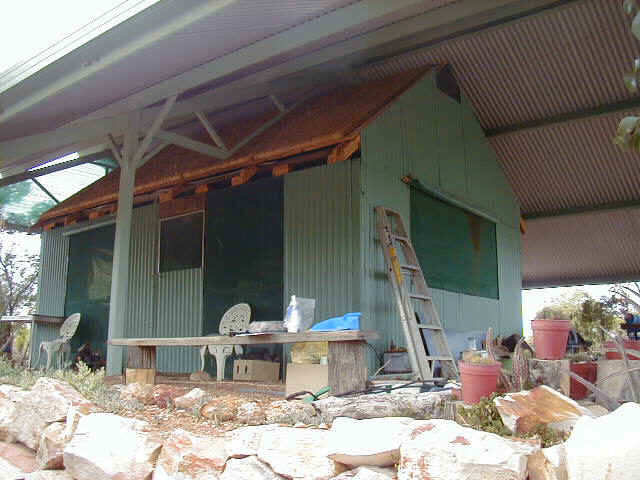 |
...and
a more typical one
|
|
To dig a mine, a 9-inch diameter drill is dug into the
earth, anywhere from 30-70 feet deep. Opal tends to be found along fault lines below the
sandstone. As I understand it, the 9-inch hole is dug; followed by another hole about 5
yards away. If there is relative change in height to the bottom of the sandstone, there is
a chance of a fault line, and with a whole lot of luck, maybe some opal. The miner then
digs multiple holes in the immediate area, keeping his fingers crossed.
| If there is evidence of quality opal, a larger,
3’ (diameter) hole is dug to the appropriate level, a ladder dropped, and the miner
climbs down to check what he/she has got. If he’s hit the "mother load",
the miner runs down to the government office and stakes his claim, 50 meters x 50 meters.
The cost to stake a claim is a mere A$200, but each individual is only allowed to make 2
claims (lifetime), so you want to be certain you have quality before you make an official
claim. |
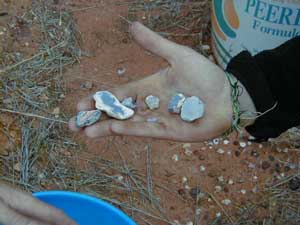 Boulder Opal: Traces of opal attached to
rock -- Very common and not very valuable |
About 10 years ago, Lightning Ridge "struck gold",
and the rush was on. Money was made by just about any fool with a drill. Today, very few
people become instant millionaires. Out of 100 miners, 2-3 may become rich, another few
can make a decent income, some more break even, and the majority just throw their money
down the holes they dig (cost of equipment, fuel, and food). Science has progressed only
so far as miners have an idea where there may be potential, but old fashioned luck is the
only sure thing.
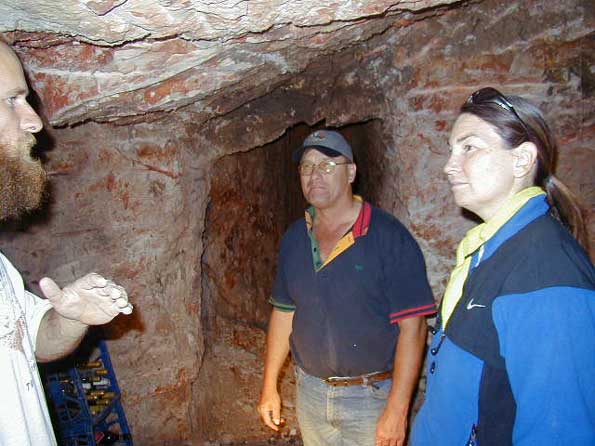 Tim explains the digging process to Jon and
Erin (35 ft below the surface). |
As darkness descended, we gathered around the open fire,
downing a few reflective ales. A tray was brought over with several Tyrannosaurus steaks;
they were HUGE! After the delicious tucker (meal), it was time to retire for the night. We
unrolled  the Thermarest mats and sleeping bags on the wooden deck, under
the star-filled night. We slept on the West side of the camp (tin wall behind our heads),
so as not to rise with the sun. I thought this would be a clever idea; Instead, I spent
the night watching the moon traverse across the sky. When the moon was finally touching
the treetops, I clenched my eyes closed, knowing it wouldn’t be long before the sky
would begin to lighten with the rising sun.
the Thermarest mats and sleeping bags on the wooden deck, under
the star-filled night. We slept on the West side of the camp (tin wall behind our heads),
so as not to rise with the sun. I thought this would be a clever idea; Instead, I spent
the night watching the moon traverse across the sky. When the moon was finally touching
the treetops, I clenched my eyes closed, knowing it wouldn’t be long before the sky
would begin to lighten with the rising sun.
A few hours later, the sky did begin to brighten.
Unfortunately, it didn’t last. Breakfast of eggs and fresh bacon was devoured, and as
we realized the threatening skies wouldn’t miss us, we hopped on the bikes. The trick
now was to get almost 200kms back to Thorndale, which was mostly dirt/gravel. Jon is an
experienced off-road rider, and his worried face began to concern me. We opted to take the
long way home (280kms), which was about 125kms of asphalt, another 125kms of
"decent" gravel, and the last 30kms were on a slippery mud surface, which was
slippery as snot (local term). We were pretty wasted when we finally pulled into the farm
– ready for a beer, a hot shower, tucker, and then sleep.
Saturday was spent doing little things around the farm.
Checking on the harvest, cleaning the bikes, fixing a leak in my front tire, and even a
bit of laundry. Jon was contemplating joining us for the 600km ride to Byron Bay. His last
field to harvest wouldn’t be ready for about 10 more days, but his quarterly tax
statement was due, and he’d have to take the ride back alone. It took a single phone
call to Jon’s friend Stu, who was already packed before they hung up.
Sunday, Oct 15th: We kissed Libby farewell, and
the four of us headed away from the farm. We were blessed with great weather and a
beautiful ride. Jon and Stu led us on fantastic roads we would not have found on our own.
We arrived at the campground in Byron Bay just before sunset, set up our tents, and went
into town for the night. In the morning, Jon and Stu were up early (they are farmers), and
at 8am, we rode to the lighthouse on the cliffs of Byron Bay, the eastern most point in
Australia.
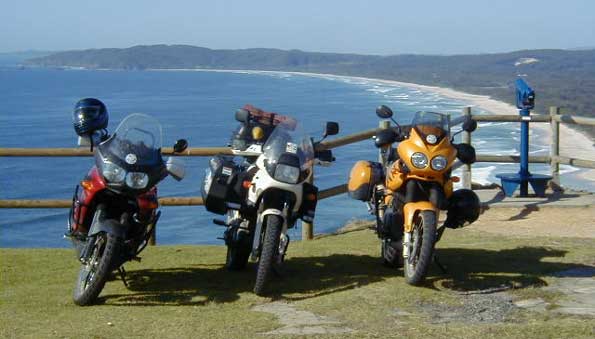 L to R: Stu, Erin, and Jon at the Byron Bay lookout
-- OZ's most eastern point |